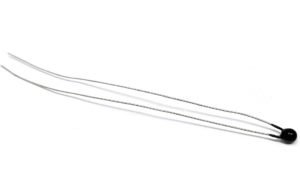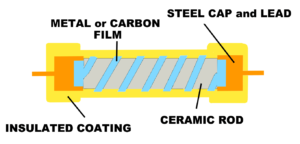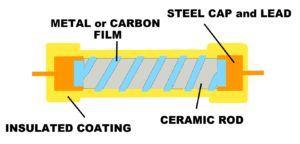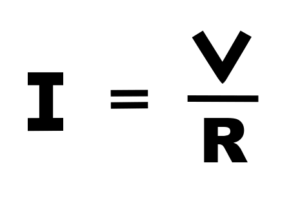
What is a Thermistor?
The necessity for temperature sensing is all around us. Transportation, food processing, the manufacturing of goods, and virtually every other activity in our modern world requires the collection and interpretation of temperature data. Thermistors play an important role in the collection of this information. They are not the only way to measure temperature so be sure to check out our blogs on thermocouples and RTDs. Today, however, let’s answer the question: what is a thermistor?

Figure 1: A 10k thermistor
An Introduction to Thermistors
A thermistor is a temperature-sensitive resistor, literally. The word “thermistor” is an amalgamation of two words: thermal and resistor. Thermal is derived from the Greek word for heat, and a resistor is a passive device used to restrict electrical current. Resistors are a widely used component in electronics and thermistors are just a special category of resistors.

Figure 2: Thermistor symbols (IEC standard left, American standard right)
Electrical current will flow into a thermistor and, due to the properties inside, a limited amount of it will flow out. We’ll take a look at what an actual thermistor looks like on the inside:

Figure 3: Inside a thermistor
There are only a few basic parts to a thermistor; two metal leads to carry a signal in and out, a metal oxide wafer, and a protective outer sheath made of glass or resin. Sometimes a type of solder is used to help fuse the leads and the core together. But in other manufacturing techniques the outer sheath compresses the leads to the core enough to keep them in place. At the heart of a thermistor is the core, a disc of metal oxide. This is a compound, or combination, of oxygen and a metal element. Such as nickel, copper, or manganese. It is this compound that alters the flow of electrons by an amount that depends on the temperature in the environment around the thermistor. This alteration of electron flow, or resistance, can be measured; we can tell how much current is flowing into one lead of a thermistor and how much less is flowing out the other lead. A thermistor will behave the same way every time, differing only depending on the surrounding temperature. Therefore, the measurable difference it is causing to the current can be related to a specific temperature.
Does all this talk about thermistors make you wonder what they are like in the real-world? Head on over and view Enercorp’s own Space Executive Air Temperature Sensor or our Outdoor Air Temperature Sensor. These are just two of many thermistor products that Enercorp custom-manufactures to our clients’ specifications. They both use thermistors to provide accurate and reliable measurements.

Figure 4: An ambient air temperature sensor, the TS-S-E-T-10K.
Now that’s a lot to take in all at once, and really by explaining what is a thermistor probably just invites more questions, like what is resistance? and are thermistors and resistors the same thing? To really understand what a thermistor is we need to delve one layer deeper and find out:
What is a resistor?

Figure 5: A 56k resistor
A Primer on Resistors
As mentioned earlier, a resistor is a passive device that can restrict the flow of electrical current.

Figure 6: Resistor symbol (IEC standard left, American standard right)
As you can see, the symbols for a resistor (Figure 6) and a thermistor (Figure 2) are incredibly alike. Physically, they act alike as well. An electrical current will flow into one end of the resistor, but, due to the properties of the materials inside, the current flow will be restricted. Let’s see how it looks inside an actual resistor:

Figure 7: Inside a resistor
Electrical current will flow through the steel lead and cap quite well. This makes it a great conductor of electricity. Inside the resistor is a spiral of semi-conductive metal or carbon film wrapped around a non-conductive ceramic rod. When the current reaches the spiral of metal or carbon it is partially resisted. Therefore only so much of the current can get through at one time. The current exits the other end of the resistor but at a reduced rate compared to how it entered. To make that concept a little easier to understand, we’ll use an analogy. Think of water travelling through your garden hose. If you squeeze the hose tighter you’re going to allow less water to pass through. Also, the water pressure is going to increase on the side before this restriction. In an electrical circuit, the current is like water and the resistor is like your hand squeezing the hose. Less current will flow past a resistor and an electrical pressure will increase in front of the resistor. This is also referred to as a voltage difference or potential. Let’s place a resistor within an electrical circuit and see what happens.

Figure 8: Resistor in a circuit
As you can see, a battery is providing the electrical current that is flowing through some copper wires. However, once that current reaches our resistor only so much can get through; the properties of our resistor restrict the flow.
Resistors are not all created equal; different types can do different amounts of work. Let’s revisit our garden hose analogy. Now, you could squeeze that garden hose really hard and restrict a lot of the water flowing through, or, you could squeeze it just lightly and restrict only a small amount from going through. The same can happen with a resistor in an electrical circuit. One type of resistor may restrict a lot of current but another type of resistor may only restrict a small amount of current. We quantify the amount of restriction with the unit ohms, represented by the Greek symbol Omega (𝝮) for short. The higher the ohms the more current the resistor will impede.
Ohm’s Law
Resistance, voltage, and current are all related. When one of the three is changed, the others are too. This relationship is a scientific fundamental; Ohm’s Law.

Figure 9: Ohm’s Law
Learning about Ohm’s Law is important to understanding the basics of how an electrical current behaves in circuits. Ohm’s law also shows us how circuits can be modified to meet certain needs of an application. You can read more detailed information about that in our blog on Ohm’s Law. What is important for our basic understanding right now is that the three variables resistance, voltage, and current, are all dependant on each other. If one variable is changed it will affect the others. The changes can be calculated using Ohm’s Law equation. If you remember a little bit of algebra from high school math class then you’ll know that equations can help you calculate unknown variables. So, if we know two out of our three variables; resistance, voltage, or current, we can use Ohm’s Law equation to calculate the unknown third variable.
Back to Thermistors
Now that we know some of the basics about resistors. We know that they will restrict the electrical current in a circuit. Also, we know that this resistance is relative to the voltage and current. Remember, voltage and current the other two variables equated by Ohm’s Law. So, let’s take that information and circle back to see if we can get a sense of how thermistors really work.
A thermistor is a type of resistor; one with special properties. A resistor will restrict current consistently. Whereas a thermistor will restrict current depending on the surrounding temperature. Thermistors subscribe to Ohm’s Law in the same way that resistors do; resistance, voltage, and current are all related. So if we have a thermistor within our circuit and we know the voltage and current variables. Then, we can calculate the resistance of the thermistor, just as if we were calculating the resistance of a resistor within a circuit. For thermistors, that calculated resistance corresponds to a respective temperature. In short, by using a thermistor in a circuit with some known variables, we can calculate the temperature of the surrounding environment.
So now you know what a thermistor is, a temperature-sensitive resistor. We spent a lot of time talking about circuits and resistors in this article. However, there is still more to learn about thermistors specifically. Check out our other blog on thermistors where we will investigate the different types of thermistors, what they are made out of, and where they are used. For now though, at least you know a little more about the fundamentals of thermistors.


